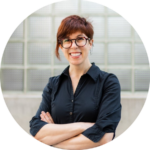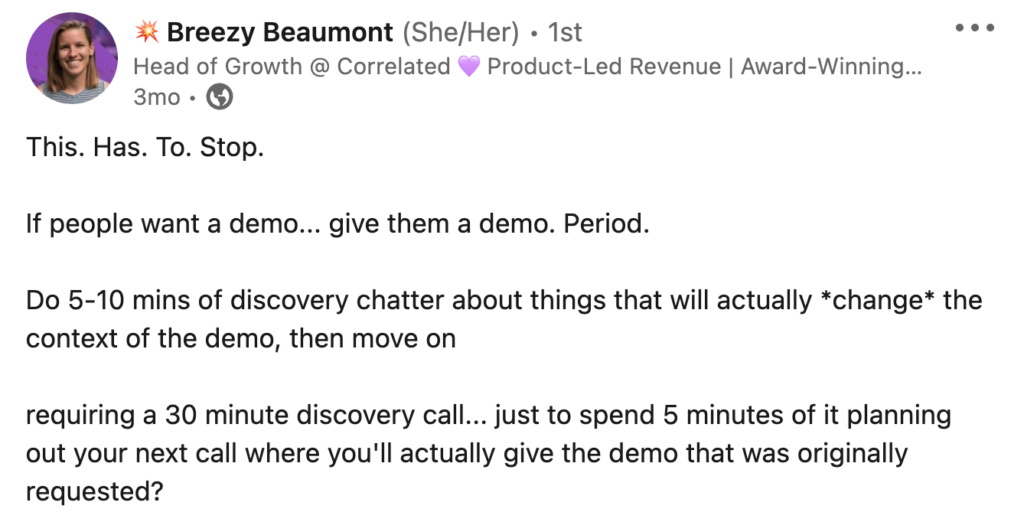“If people want to demo… give them a demo. Period.“
Breezy Beaumont had unknowingly sparked a controversial debate—one that gathered over 4,500 reactions and nearly 1,000 comments on how B2B software sales should be done.
Echoing Beaumont, Chili Piper’s Arthur Castillo commented:
“Too many companies are forcing buyers down their sales process vs. meeting customers where they are at and allowing them to buy at their pace.”
On the other hand, Henry Briggs, a marketing program manager, felt a longer discovery is justified for complex and costly software:
“For solutions where the price is a real barrier (often, the greatest barrier) skipping over discovery, going straight to demo, and/or giving trials without proper education and context will cause many potential customers to get lost and fall through the cracks.”
Interestingly, both views can be summarized into two schools of thought:
- Your demo is only as good as your discovery. It’s not a one-size-fits-all solution, so tailor it as the best solution to the buyer’s pain points.
- Get your product demo into the buyer’s hands faster. Limit the number of discovery calls and give the demo when the client wants it.
As CEO and Co-Founder of Demostack, I’m constantly talking to the market about their demo strategy, and how they approach this topic.
Here’s my take: Both sides are valid, but just like any complex problem, there’s a nuance you need to understand.
The traditional B2B sales motion
As it stands, B2B sales has a tried and tested formula that every sales organization tries to emulate.
- Lead requests a demo
- SDR hops on the first call to qualify them using the BANT criteria
- Those who pass are booked for a second discovery call with the AE
- AE leads the discovery, collecting intel related to the lead’s pain points, how they are currently tackling the said pain points, their expectations and desired outcomes, their decision-making process, and the like
- Schedule another call for clarification if needed
- The next call is the big reveal: a custom product demo tailored to the lead’s exact needs and use case
- You get a Closed Won
There’s a reason why this approach has worked for decades.
Presenting a customized solution to your lead, with an SE to handle the technical questions, makes it easier for your prospect to visualize your product/service within their existing environment.
Related: Demo-Litions: Two Sales Nerds React to Real Sales Demos & Share Advice for Demos That Sell
However, we cannot ignore the modern buyer’s expectations have changed. As Beaumont rightly pointed out in her LinkedIn post, “Your competitors are giving a demo when people want it…putting demos on their website…are letting people use their product before they buy it.”
Clearly, the tried and true B2B sales process needs an update.
See original post, by Breezy Beaumont @ Correlated
The product-led B2B sales motion
Product-led growth or PLG puts the spotlight on the product.
By letting the product sell itself, you simplify the buying process for your buyer and give them faster access to the product. No friction. No gated product experiences.
Related: Product-Led-Growth and Outbound Sales: Does It Work?
Notice how the focus here isn’t only around the sales process. The buying process is equally prominent. It’s one of the main reasons why the PLG perspective works.
Even though you’re selling to a business, actual people decide whether your product/service is worth the company’s money. Plus, their expectations of a seamless experience don’t differ much from consumers.
Consider the following stats from Gartner:
- The modern buyer does 80% of the research before talking to a sales rep
- 33% of all buyers prefer a seller-free sales experience
- 44% of Millennials, the next-generation buyers, prefer a seller-free experience
The majority of buyers don’t like being forced into having multiple sales conversations before even seeing what they want to see: the product/service.
And that doesn’t mean presenting generic, canned product demos is the only solution.
Related: 3 Discovery Call Questions that Unlock Amazing Potential
The demo efficiency frontier
Both schools of thought are valid. I won’t claim one side of the debate is right and the other wrong.
Seeing the direct relationship between the time investment from the buyer and the expected level of customization, I propose a methodology that can help sales organizations strike the right balance between both factors: the demo efficiency frontier.

Ideally, your product demo should be a mirror. It should precisely reflect what your customer gets after signing on the dotted line, showcasing their crucial goals and how they can leverage your product/service to achieve them.
As you may now realize, this cannot always be a reality.
Instead, you can use diverse levels of mirroring to showcase in your product demo:
- Generic demo
- Company template: business vertical or size (enterprise, government)
- Company + persona + template: persona + vertical + size (fintech company for CRO, SMB for Head of Sales)
- Company + user-specific: persona + industry + skinned customizations (think: company name, prospect name)
- Mirrored customer: All of the above, with workflows and content speaking to the buyer’s individual use cases
The total time requested from the buyer must correlate to the level of blueprint customization done after discovery, based on this scale:
- Immediate access: Product-led growth
- Light: Demo on the first call (product-led sales)
- Heavy: Multiple calls before a demo (traditional B2B sales)
If you ask prospects for more time, every minute should translate to deep-level customizations. Otherwise, you’ve simply wasted the prospect’s time. Sales must chart a map between the customer and product usage. That’s what makes a solid product demo.
Related: How ZoomInfo Converts Hundreds of Leads in a Single Day: “Demo Day”
If you don’t ask for a time commitment, showing a generic demo is completely acceptable. Many buyers are okay with seeing a generic demo if they can get their hands on the product faster. Discuss this with the prospect early to align expectations.
Several buyers are also happy to invest more time during discovery to see a deeply customized demo showcasing how their business would benefit from your solution. But this depends on your industry specifics and the deal size.
Think of it this way: the larger the deal, the higher the touch, and the higher the prospect’s customization expectation. After all, due diligence before closing these deals is only appropriate if you’re trying to close, say, a seven-figure deal.
Don’t try jumping on a call with the prospect every time you have discovery questions, though.
Related: 12 Discovery Questions to Ask Your Prospects In Sales Calls
Try finding the answers yourself to minimize the time commitment from your buyer. Alongside thorough research, partner with your company’s RevOps leader to get this data. Online platforms like LinkedIn and Crunchbase, as well as certain B2B database software and tools like RevenueBase also work well.
Presenting fully-reflected product demos with no time commitment is the ultimate dream. But offering something with a light level of customization can still accomplish great things, depending on where you fall on the efficiency curve.
The disco demo approach
If you cannot choose between the sales motions, then don’t. You don’t have to. Instead, take the path of progressive demos. Show a demo vignette on the first sales call, then ask for extra time to show a fully customized demo in a follow-up call.
Let’s call this a disco demo of sorts.
Related: The Sales Hacker Disco Demo Guide: How to turn Discovery calls into Demos that Win
The modern buyer wants to see the product as fast as possible, but this doesn’t magically remove the need for discovery. Showing a disco demo ticks several things off the list, including:
- Satisfying customers wanting to get a feel of the product/service right away
- Piquing enough client interest to make them want to see more
- Providing enough conversation fodder to turn your demo into a two-way dialogue
This creates the optimal situation, where the prospect is happy to wait and give you more time to prepare a heavy-hitting custom demo using the insights you learned about their business goals.
Its true complex solutions built for enterprise use cannot just be handed out and taken for a test drive. But this doesn’t mean you can’t combine elements of the PLG mindset with a high-touch sales motion, helping you simplify your buyer’s buying process without flattening the aha moment.
Measure, iterate, repeat
Be sure to measure the impact of your decisions before modifying your existing demo strategy.
Test each level of customization and time commitment based on your sales cycle stages and customer segments. Then track the impact they have on your revenue acceleration.
At Demostack, we consider the following questions before making any changes to our business processes:
- Is there any uplift in the win rate when a demo is shown on the first call?
- How is deal velocity affected when we use Level 2 vs. Level 4 customization?
- Can our sales reps handle more deals if they spend less time on customization? If yes, is the trade-off worth it?
- What is the customization point after which sales productivity drops?
- How does Demo Template A perform vs. Demo Template B when considering attributed revenue?
Setting up an experimentation framework to find your sweet spot is another option. This will enable you to test hypotheses in different areas of the efficiency frontier, facilitating data-driven decisions.
You’ll still find a lot of gray areas between the different levels of mirroring. Instead of using the demo efficiency frontier as a sales playbook solution, treat it as a guideline to help you change course based on your buyer’s preferences. You can also use modern demo tools to pivot on the fly based on the conversation with your clients, removing friction and frustration from the buying process.
Related: 5 Must-Have Steps on Your Discovery Call Checklist
Accelerate revenue with better demos
Your product demo is the proof behind your value proposition, and how you showcase it significantly impacts your business. Finding your sweet spot on the efficiency curve will ultimately accelerate revenue—and with modern demo platforms, you can simulate the ideal demo environment without actual deployment and technical know-how.
The first ones to understand this and adapt will secure their market position and thrive in the long run.
 Edited by Kendra Fortmeyer @ Sales Hacker 2022
Edited by Kendra Fortmeyer @ Sales Hacker 2022








